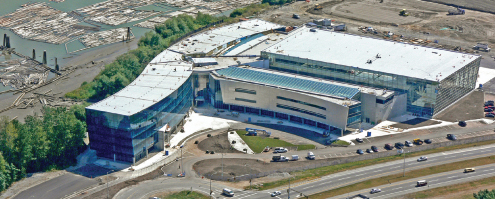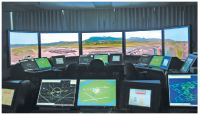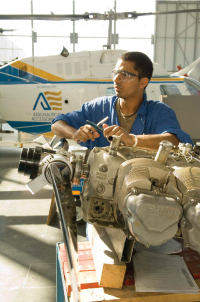
News
BCIT: 50 years of aerospace excellence
At a grand opening ceremony in October, the British Columbia Institute of Technology (BCIT) opened its new Aerospace Technology Campus (ATC) to the public. The ATC, a 28,300-square-metre facility that cost $77 million, is situated on Sea Island, home of the Vancouver International Airport. The campus, which incorporates state-of-the-art facilities and teaching technologies, can accommodate 1,000 students, more than double BCIT’s previous capacity.
June 6, 2008 By Blair Watson
At a grand opening ceremony in October, the British Columbia Institute of Technology (BCIT) opened its new Aerospace Technology Campus (ATC) to the public. The ATC, a 28,300-square-metre facility that cost $77 million, is situated on Sea Island, home of the Vancouver International Airport. The campus, which incorporates state-of-the-art facilities and teaching technologies, can accommodate 1,000 students, more than double BCIT’s previous capacity.
 |
| BCIT’s new Aerospace Technology Campus is located on Sea Island and can accommodate 1,000 students. (Photo by Jim Jorgenson) |
“BCIT has a long and proud history as a leader in aerospace training, having supplied the aviation industry with more than 5,000 graduates over the past 50 years,” said the acting president of BCIT, Dr. Verna Magee-Shepherd. “This spectacular new facility will ensure that we continue to meet industry demand for workers by providing hands-on, technology-driven education, the cornerstone of our polytechnic mandate.”
The ATC was designed by Kasian Architecture Interior Design and Planning Ltd. and built by Ledcor Construction Ltd., two prominent companies in their respective fields in BC. Building the ATC involved 2,300 workers and 377,662 construction hours, 11,000 cubic metres of concrete, and approximately 1,700 glass panels. It has more than 40 ‘smart’ classrooms and laboratories equipped with the latest wireless and multimedia technology, and 22 workshops where industry conditions are duplicated.
The campus has an integrated research and resource library, a lecture theatre with global teleconferencing capa-bilities, 36 faculty offices, lounges, a cafeteria, and a gym. The 3,716-square-metre Honeywell Aerospace Education Hangar houses BCIT’s fleet of 23 aircraft, including a Boeing 737-200 donated by WestJet Airlines. The hangar has six, 12.5-metre-high doors, spanning 60 metres in total, which can be opened and closed by just one person thanks to two drive motors.
The ATC’s design comprises a spacious central hub and three wings: A main entry and administrative zone (the 3-storey West Wing), an office space and workshop zone along the Fraser River (the 5-storey North Wing), and a classroom and workshop zone (the 2-storey South Wing) that includes faculty offices.
ATC stands for not only Aerospace Technology Campus, but also air traffic control. BCIT is the first aerospace training institute in Canada to have an air traffic management laboratory utilizing 3-D animation technology. The Raytheon FIRSTPlus simulator simulates enroute and terminal air traffic environments, including 3-D animation that replicates what controllers in a tower cab see looking outside. The simulation technology was donated by Raytheon Canada and the lab was partly funded by the federal government.
 |
| The Raytheon FIRSTPlus simulator simulates enroute and terminal air traffic environments, including 3-D animation that replicates what controllers in a tower cab see looking outside. (Photo courtesy of Raytheon Canada) |
Raytheon was not the only aerospace company to donate leading-edge technology to help BCIT train students. Honeywell Aerospace donated a $2.2-million ‘glass cockpit’ that represents the latest in digital avionics. Unlike the ‘steam’ gauges in aircraft of a generation or more ago, many modern airplanes are equipped with sophisticated computerized displays. With Honeywell’s contribution, BCIT will continue to offer training in advanced avionics systems for many years to come.
The ATC not only has modern aviation technologies, but also 21st-century ‘green’ systems. The building’s geothermal pump utilizes the hangar slab as a radiant source with air-to-air heat recovery providing heating for adjacent shops and classrooms. The heat pump is also used in the primary heating and chilled water system. The large volume of warm air generated in the hangar provides a source of heating for two levels of workshops on the space’s perimeter. The heating system for the hub and two large circulation atriums employs a similar approach; return air is used for heating before being exhausted. Operable windows on the east and west sides allow for cooling and ventilation.
On June 2, 2003 the BC Government announced that it would provide $16.4 million to BCIT for a project focused on meeting the educational needs of a growing provincial aerospace industry. In 2004, BCIT embarked on a campaign, “Soaring to Excel,” to invite industry partners to provide funding support for the ATC. Twenty-two companies, seven non-profit organizations, four individuals, and two estates donated a total of $10 million.
Nationally, aerospace is a $22-billion industry that employs 75,000 workers; Canada is the world’s fourth-largest provider of aerospace services and products. According to industry estimates, 10,000 new aerospace professionals will be needed by 2011.
In BC, the annual revenues of aerospace manufacturing and maintenance companies total about $1.25 billion. Four hundred companies employ 10,000 personnel, paying $426 million in salaries and wages. Aerospace jobs include the maintenance, repair and overhaul (MRO) of airplanes and helicopters, and high-tech work in space technology, manufacturing, engineering and special processes.
Notable aerospace companies in BC include Avcorp Industries (designer and manufacturer of major airframe structures), Viking Air (manufacturer of the new Twin Otter 400 series and components for de Havilland aircraft), Vector Aerospace (independent provider of MRO services for fixed wing and rotary wing aircraft operators around the globe), Cascade Aerospace (aircraft MRO and aviation product engineering), Air Canada Technical Services (MRO provider), MTU Maintenance (turbine engine repair and overhaul services), and MacDonald, Dettwiler and Associates (operator of space, air, and sea-based data-gathering platforms and information provider with civilian, defence and commercial clients).
BCIT has become one of the top aerospace training schools in North America because of the vision, dedication, and hard work of many people over the past 50 years. Apprenticeship programs at the Federal Provincial Technical Training Institute (FPTTI) and British Columbia Vocational School (BCVS) – the predecessors of BCIT – were based on the Aircraft Apprentice Scheme (AAS) that was introduced in Great Britain in 1920. Young men aged 15 and older would receive 20 hours per week of technical training in workshops, nine hours of physical training, and eight hours of education. BCIT’s aerospace programs reflect the approach of theoretical instruction and hands-on experience developed in Britain 80+ years ago.
In 1957, the provincial government appointed LCol John W. Inglis to be the first FPTTI principal. Under his leadership and the guidance of instructors such as Geoff Bateman, Pete Mills, and Cy Tinley – AAS graduates – the first aviation training program was developed. Students spent equal amounts of time in class and the workshop learning aircraft engine maintenance.
 |
| A student participates in the hands-on component of the AME training, an integeral part of the aerospace training at BCIT. (Photo by Scott McAlpine) |
BCVS opened in June 1960, initially offering 14 aviation-related courses, from six months for most trades to two years for aeronautics. In the same year, “aerospace” replaced “aviation” in the school’s training manuals. For the rest of the decade and into the 1970s, the BCVS aerospace program grew significantly, training hundreds of skilled workers for aviation fields that included not only aircraft maintenance, but also flight operations and airport management and maintenance engineering.
By mid-1978, BVCS and another educational organization, the Haney Education Centre, were amalgamated under the direction of BC’s education minister, Dr. Pat McGeer, to become the Pacific Vocational Institute. The PVI Aerospace Program was relocated to a large hangar on the south side of Sea Island. The larger space and expanding fleet of fixed- and rotary-wing aircraft allowed PVI to train 400 aerospace students.
PVI and the BCIT merged in 1986 under the BCIT name. During the 1990s, the aerospace program continued to expand as much as the physical facilities allowed. By 2000, the old hangar was becoming crowded and a new facility that incorporated the latest in aerospace technologies clearly needed to be built. A five-hectare parcel of land on the east side of Sea Island was purchased by BCIT and planning and design of the ATC began.
Less than a year has passed since BCIT’s new Aerospace Technology Campus was completed, and the facility is filled with several hundred students eager to learn their chosen craft. They will enjoy an aerospace educational experience that is unparalleled in Canada. It will surely remain so for decades
to come.